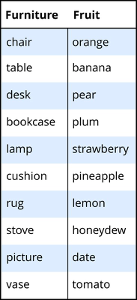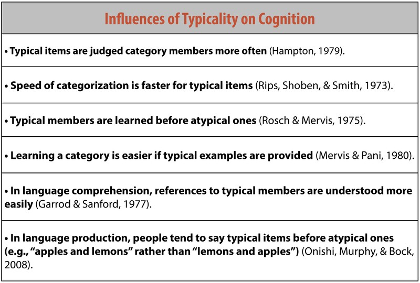7.3: Concepts and Categories
- Page ID
- 92743
Fuzzy Categories
Borderline Items
Experiments also showed that the psychological assumptions of well-defined categories were not correct. Hampton (1979) asked subjects to judge whether a number of items were in different categories. He did not find that items were either clear members or clear nonmembers. Instead, he found many items that were just barely considered category members and others that were just barely not members, with much disagreement among subjects. Sinks were barely considered as members of the kitchen utensil category, and sponges were barely excluded. People just included seaweed as a vegetable and just barely excluded tomatoes and gourds. Hampton found that members and nonmembers formed a continuum, with no obvious break in people’s membership judgments. If categories were well defined, such examples should be very rare. Many studies since then have found such borderline members that are not clearly in or clearly out of the category.

McCloskey and Glucksberg (1978) found further evidence for borderline membership by asking people to judge category membership twice, separated by two weeks. They found that when people made repeated category judgments such as “Is an olive a fruit?” or “Is a sponge a kitchen utensil?” they changed their minds about borderline items—up to 22 percent of the time. So, not only do people disagree with one another about borderline items, they disagree with themselves! As a result, researchers often say that categories are fuzzy, that is, they have unclear boundaries that can shift over time.
Typicality
A related finding that turns out to be most important is that even among items that clearly are in a category, some seem to be “better” members than others (Rosch, 1973). Among birds, for example, robins and sparrows are very typical. In contrast, ostriches and penguins are very atypical (meaning not typical). If someone says, “There’s a bird in my yard,” the image you have will be of a smallish passerine bird such as a robin, not an eagle or hummingbird or turkey.
You can find out which category members are typical merely by asking people. Table 1 shows a list of category members in order of their rated typicality. Typicality is perhaps the most important variable in predicting how people interact with categories. The following text box is a partial list of what typicality influences.
We can understand the two phenomena of borderline members and typicality as two sides of the same coin. Think of the most typical category member: This is often called the category prototype. Items that are less and less similar to the prototype become less and less typical. At some point, these less typical items become so atypical that you start to doubt whether they are in the category at all. Is a rug really an example of furniture? It’s in the home like chairs and tables, but it’s also different from most furniture in its structure and use. From day to day, you might change your mind as to whether this atypical example is in or out of the category. So, changes in typicality ultimately lead to borderline members.

Source of Typicality
Intuitively, it is not surprising that robins are better examples of birds than penguins are, or that a table is a more typical kind of furniture than is a rug. But given that robins and penguins are known to be birds, why should one be more typical than the other? One possible answer is the frequency with which we encounter the object: We see a lot more robins than penguins, so they must be more typical. Frequency does have some effect, but it is actually not the most important variable (Rosch, Simpson, & Miller, 1976). For example, I see both rugs and tables every single day, but one of them is much more typical as furniture than the other.
The best account of what makes something typical comes from Rosch and Mervis’s (1975) family resemblance theory. They proposed that items are likely to be typical if they (a) have the features that are frequent in the category and (b) do not have features frequent in other categories. Let’s compare two extremes, robins and penguins. Robins are small flying birds that sing, live in nests in trees, migrate in winter, hop around on your lawn, and so on. Most of these properties are found in many other birds. In contrast, penguins do not fly, do not sing, do not live in nests or in trees, do not hop around on your lawn. Furthermore, they have properties that are common in other categories, such as swimming expertly and having wings that look and act like fins. These properties are more often found in fish than in birds.

According to Rosch and Mervis, then, it is not because a robin is a very common bird that makes it typical. Rather, it is because the robin has the shape, size, body parts, and behaviors that are very common among birds—and not common among fish, mammals, bugs, and so forth.
In a classic experiment, Rosch and Mervis (1975) made up two new categories, with arbitrary features. Subjects viewed example after example and had to learn which example was in which category. Rosch and Mervis constructed some items that had features that were common in the category and other items that had features less common in the category. The subjects learned the first type of item before they learned the second type. Furthermore, they then rated the items with common features as more typical. In another experiment, Rosch and Mervis constructed items that differed in how many features were shared with a different category. The more features were shared, the longer it took subjects to learn which category the item was in. These experiments, and many later studies, support both parts of the family resemblance theory.


